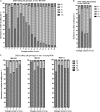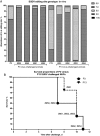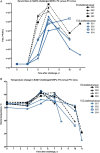Genetic Changes at the Glycoprotein Editing Site Associated With Serial Passage of Sudan Virus
- PMID: 25920319
- PMCID: PMC6283357
- DOI: 10.1093/infdis/jiv216
Genetic Changes at the Glycoprotein Editing Site Associated With Serial Passage of Sudan Virus
Abstract
Sudan virus (SUDV), like the closely related Ebola virus (EBOV), is a filovirus that causes severe hemorrhagic disease. They both contain an RNA editing site in the glycoprotein gene that controls expression of soluble and full-length protein. We tested the consequences of cell culture passage on the genome sequence at the SUDV editing site locus and determined whether this affected virulence. Passage resulted in expansion of the SUDV editing site, similar to that observed with EBOV. We compared viruses possessing either the wild-type or expanded editing site, using a nonhuman primate model of disease. Despite differences in virus serum titer at one time point, there were no significant differences in time to death or any other measured parameter. These data imply that changes at this locus were not important for SUDV lethality.
Keywords: RNA editing; Sudan virus; cell culture adaptation; editing site; glycoprotein.
© The Author 2015. Published by Oxford University Press on behalf of the Infectious Diseases Society of America. All rights reserved. For Permissions, please e-mail: journals.permissions@oup.com.
Figures





References
-
- Marsh GA, Haining J, Robinson R et al. . Ebola reston virus infection of pigs: clinical significance and transmission potential. J Infect Dis 2011; 204(suppl 3):S804–9. - PubMed
-
- Baize S, Pannetier D, Oestereich L et al. . Emergence of Zaire Ebola virus disease in Guinea. N Engl J Med 2014; 371:1418–25. - PubMed
-
- Sobrino F, Dávila M, Ortín J, Domingo E. Multiple genetic variants arise in the course of replication of foot-and-mouth disease virus in cell culture. Virology 1983; 128:310–8. - PubMed
Publication types
MeSH terms
Substances
Grants and funding
LinkOut - more resources
Full Text Sources
Other Literature Sources
Medical

